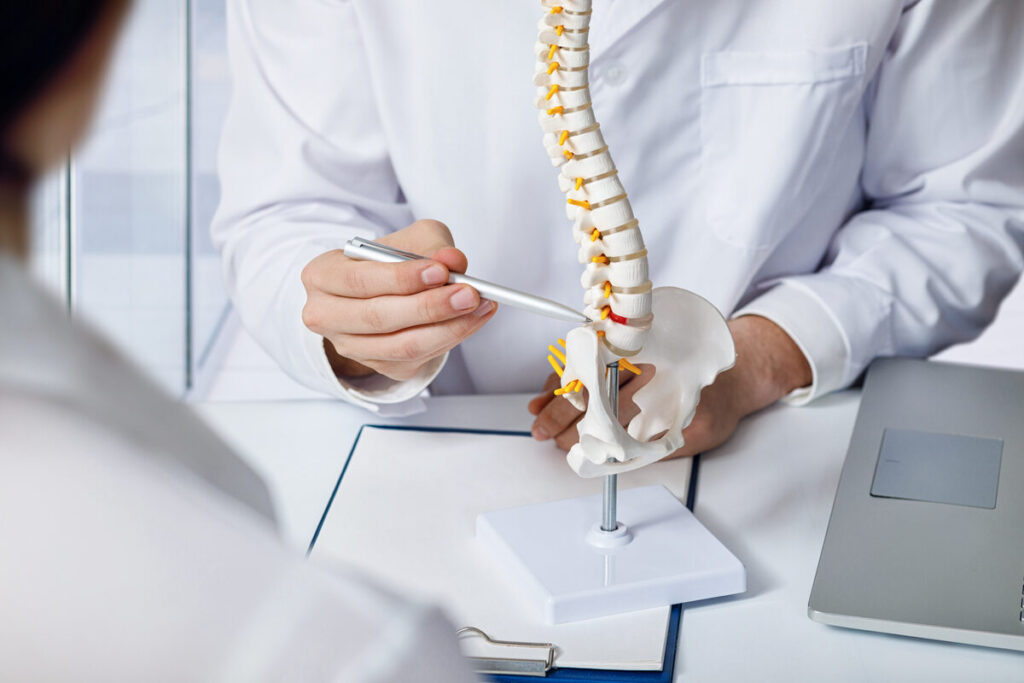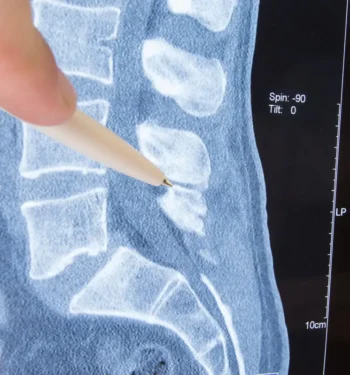
Understanding When Surgery Is Needed for Spinal Stenosis
Spinal stenosis can significantly impact daily life, causing debilitating pain and reduced mobility. While nonsurgical interventions can help manage spinal stenosis symptoms, including lower back pain, leg cramping, and weakness in the legs or feet, there comes a point when surgery may be the most effective solution.
You may wonder, at what point does spinal stenosis require surgery? Or ask, how do I know if my spinal stenosis is severe? This article explores when spinal stenosis surgery is necessary, how to identify severe cases, and which treatments might work best. At Goodman Campbell, our spine specialists guide you through every step, providing expert diagnosis and personalized care. If you’re seeking spinal stenosis treatment in Indiana, we’re ready to help.
At What Point Does Spinal Stenosis Require Surgery?
Spinal stenosis surgery is typically recommended when conservative treatments fail or the condition begins to significantly affect your quality of life. Here are common surgery indications that can help determine when intervention may be necessary:
- Persistent Nerve Symptoms: Worsening numbness, weakness, or tingling in the arms or legs may signal nerve compression. Bowel or bladder issues can also suggest that surgery is needed.
- Growing Disability: Struggling with daily tasks — walking, climbing stairs, or getting out of bed — may indicate that spinal stenosis is progressing.
- Failed Nonsurgical Treatments: If physical therapy, medication, or injections haven’t provided relief, surgery may be the next step.
At Goodman Campbell, our team takes a collaborative approach to back and spinal care, offering effective, minimally invasive surgical options when needed. Talk to your doctor to learn more about the advanced care we provide.
How Do I Know if My Spinal Stenosis Is Severe?
Severe spinal stenosis causes symptoms that go beyond mere discomfort and can, in fact, start to pose serious risks to your well-being. Common signs include:
- Intense Pain and Reduced Mobility: Pain radiating through the legs or back, along with difficulty walking or standing upright, may signal severe spinal stenosis.
- Neurological Symptoms: Worsening weakness, numbness, or sudden loss of bladder/bowel control are red flags indicating a need for immediate medical attention.
Diagnosis typically involves MRI or CT scans, physical exams, and neurological assessments. If your spinal stenosis symptoms are worsening, promptly seek an evaluation by a specialist, as early intervention can help prevent complications and support mobility recovery.
Who Is Not A Candidate for Spinal Stenosis Surgery?
While surgery can be life-changing for many, it’s not right for everyone. Factors that may affect candidacy or pose contraindications to spinal stenosis surgery include:
- Existing Medical Conditions: Uncontrolled diabetes or serious heart issues can increase surgical risks.
- Preference for Conservative Care: Some patients choose to manage their symptoms nonsurgically if the symptoms remain tolerable.
- Bone Quality and Overall Health: Patients with conditions including osteoporosis, as well as those with poor overall health or lifestyle factors that limit healing, may not be ideal spinal stenosis surgery candidates.
At Goodman Campbell, our back and spine healthcare professionals assess each patient’s unique needs to recommend the best care plan. Ask your doctor about our personalized approach to spinal stenosis treatment.
What Is the Most Successful Treatment for Spinal Stenosis?
The ideal treatment depends on the severity of your condition. Here’s a breakdown of options:
- Nonsurgical Options (How do you fix spinal stenosis without surgery? Here are some proven methods to consider):
- Physical Therapy: Strengthens muscles supporting the spine.
- Interventional Pain Management: Including corticosteroid and epidural injections
- Lifestyle Adjustments: Weight control and gentle exercise can help relieve symptoms.
- When Surgery Is the Best Option:
- Patients with severe symptoms or those who have exhausted conservative care often find surgery to be the most successful treatment for spinal stenosis. Minimally invasive procedures, such as laminectomy or spinal fusion, relieve pressure on the spinal cord and nerves, improving pain and mobility.
Goodman Campbell’s team specializes in spinal stenosis treatment plans tailored to each patient. Whether you need surgery or prefer to explore nonsurgical care, you’ll have a trusted partner by your side.
What Is the Success Rate of Surgery for Spinal Stenosis?
Spinal stenosis surgery boasts a high success rate, with many patients reporting substantial pain relief and improved mobility. What is the most successful surgery for spinal stenosis? Procedures such as laminectomy often top the list, with studies showing success rates often up to 80%.* However, the overall success rate of spinal stenosis surgery can vary based on the type of procedure and the patient’s overall health, with long-term spinal surgery outcomes often dependent on factors such as post-operative care, rehabilitation, and surgical precision.
At Goodman Campbell, patient satisfaction is our top priority. With state-of-the-art techniques, expert surgeons, and a proven track record of patient success, our focus is on delivering the best possible outcomes so you can return to living a life you love.
What Is The Newest Treatment for Spinal Stenosis?
Advances in minimally invasive spinal surgery are transforming how we treat spinal stenosis, but what is the newest treatment for spinal stenosis?
Techniques such as endoscopic decompression, artificial disc replacement, and arthroplasty offer effective relief and innovative care through less invasive means. These procedures represent the newest treatment for spinal stenosis. Compared to other techniques, they may carry fewer risks and offer a faster recovery with minimal scarring.
You might also wonder, What is the most successful surgery for spinal stenosis? While minimally invasive options are advancing, laminectomy and related procedures remain among the most effective when severe nerve compression is present. The right approach depends on your symptoms, anatomy, and overall health, making a personalized care plan essential.
At Goodman Campbell, we utilize the latest technologies in monitoring and diagnosis to ensure precise evaluation and optimal treatment planning. If you’re interested in the newest treatments for spinal stenosis, speak to your physician today.
Is Spinal Stenosis Surgery Dangerous?
Like any surgical procedure, spinal stenosis surgery involves potential risks, which may include infection, nerve damage, or blood clots. However, with experienced neurosurgeons and advanced techniques, such complications are rare. Neurosurgery centers such as Goodman Campbell follow strict safety protocols, ensuring that surgery risks are minimized and patients feel confident in their care.
How Long Does Spinal Stenosis Surgery Take and What Is the Recovery Time?
Most minimally invasive procedures, such as endoscopic decompression, take 1–3 hours, while more complex surgeries, such as spinal fusion, may take longer. Duration varies based on the severity of the condition, the number of affected levels, the surgical approach, and the patient’s anatomy. Minimally invasive surgeries often allow same-day discharge or a 1-day stay; more involved procedures may require 2–3 days in the hospital.
The spinal surgery timeline extends beyond the operating room. Surgery for spinal stenosis recovery time typically spans a few weeks for minor procedures and up to a few months for more complex cases, depending on pain levels, mobility, and how quickly a patient returns to daily activities.
To aid recovery, Goodman Campbell prescribes rehabilitation plans tailored to each patient’s needs and lifestyle. Follow your care team’s instructions, engage in guided physical therapy, and stay active within your limits.
What Is the Best Way to Manage Pain Associated With Spinal Stenosis, and How Do You Fix Spinal Stenosis Without Surgery?
Pain management for spinal stenosis depends on several factors, including your individual experience and other health considerations. For many patients, nonsurgical pain management options can provide relief from discomfort.
Many patients benefit from nonsurgical spinal stenosis treatments including physical therapy, weight management, and low-impact exercise. Integrative therapies such as acupuncture or chiropractic care may provide added relief when supervised by a medical professional.
While nonsurgical methods won’t reverse spinal narrowing, they can manage symptoms and improve mobility. A team-based approach led by your provider will help ensure you receive safe, personalized care.
Conclusion: Working With a Team to Decide Your Best Option
Making decisions about spinal stenosis treatment – from initial diagnosis to post-operative care — can feel overwhelming, but it doesn’t have to be. At Goodman Campbell, we take a personalized, patient-first approach to spinal care, collaborating with peers to consider every option for each patient. Whether you’re exploring nonsurgical methods or preparing for spinal stenosis surgery, our back and spine care team is here to help you identify the best treatment options for lasting relief and improved quality of life.
Don’t wait for your symptoms to worsen. Request an appointment at Goodman Campbell today and take the first step forward to a more active lifestyle and improved quality of life.
*Haddadi K, Ganjeh Qazvini HR. Outcome after Surgery of Lumbar Spinal Stenosis: A Randomized Comparison of Bilateral Laminotomy, Trumpet Laminectomy, and Conventional Laminectomy. Front Surg. 2016 Apr 8;3:19. doi: 10.3389/fsurg.2016.00019. PMID: 27092304; PMCID: PMC4824790.
